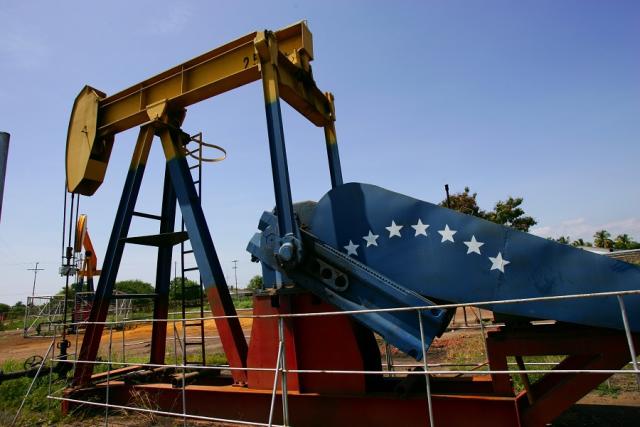
An oil extraction pump at an oil field in Lagunillas, Venezuela. (Source: Shutterstock.com)
Chevron Corp.’s Venezuelan oil production has increased by about 80% since November when Washington gave the go-ahead to re-engage in production operations in the OPEC country.
The California-based oil giant has seen production rise at its four joint ventures (JV) in Venezuela despite the poor state of the country’s infrastructure, Chevron Chairman and CEO Mike Wirth said Jan. 27 during the company’s quarterly webcast.
“They’re producing about 90,000 barrels a day now, which is up about 40,000 barrels a day since we saw the change in these license terms,” Wirth said. Prior to U.S. sanctions levied on Venezuela in early 2019, the JVs produced an average 200,000 bbl/d, according to Chevron data.
Venezuela is home to the world’s largest oil reserves at around 304 Bbbl, according to BP. The South American country holds great potential to boost oil production and exports amid reduced energy flows from Russia after its invasion of Ukraine and subsequent sanctions last year.
Wirth said that the company is continuing to work on the ground to expand production.
RELATED
Column: Much Ado About Venezuelan Sanctions
Chevron’s JVs in Venezuela are Petroboscán, Petroindependiente, Petropiar, and Petroindependencia.
“We've got a couple of cargos coming into our Pascagoula refinery,” Wirth said. “We're going to be delivering cargos to other customers on the Gulf Coast and then the revenues go into a series of structured channels to pay expenses and other obligations.”
Global production to grow modestly in 2023
Chevron saw its global net production reach 3.01 MMboe/d in fourth-quarter 2022 and 3 MMboe/d for the full-year 2022, Chevron CFO Pierre Breber said during the webcast. Production for both the quarter and year was down 3% compared to their respective periods in 2021. Production abroad fell 7% in 2022, mainly owing to the end of concessions in Thailand and Indonesia, while production in the U.S. rose 4% compared to 2021, mainly in the Permian Basin.
The Permian is now contributing nearly 25% of Chevron’s production. It’s Midland and Delaware basins averaged 738,000 boe/d in fourth-quarter 2022 — an 8% increase year-over-year, Tudor, Pickering, Holt & Co. (TPH) said in a Jan. 27 report. The company said it’s on track to average 1 MMboe/d by 2025.
“As a reminder, Chevron's share of production is lower under certain international contracts when actual prices are higher than assumed in our guidance,” Breber said.
In 2023, Chevron expects production to come in flat to up 3% at $80/bbl Brent after adjusting for lower prices and portfolio changes, primarily the divestment of its Eagle Ford assets and the expiration of a contract in Thailand, Breber said. The Permian and other shale and tight assets will anchor production in the new year.
Chevron’s upstream volumes were lower than TPH’s “projected 3.10 MMboe/d and the Street’s 3.09 MMboe/d,” according to its research report.
Strong quarterly, yearly earnings
Chevron’s adjusted earnings reached $7.9 billion in fourth-quarter 2022 compared to $4.9 billion in fourth-quarter 2021. Adjusted earnings in the most recent quarter primarily excluded a $1.1 billion international upstream write-off and impairment charges. For the full year, adjusted earnings more than doubled to $36.5 billion compared to $15.6 billion in 2021.
A day prior to the webcast, Chevron’s board declared a 6% increase to its quarterly dividend and a $75 billion buyback of shares.
RELATED
Chevron Ups Dividend, Authorizes $75 Billion Share Buyback
“Our model currently assumes $9 billion of buybacks in 2023 as our commodity deck is lower than what was realized in 2022, though first quarter buybacks are expected to stay at the approximate $3.8 billion pace,” Jefferies wrote Jan. 27 in its research report.
Wirth said that in 2022, Chevon delivered on its financial priorities: returning cash to shareholders, investing capital efficiently and paying down debt.
“We remain focused on returns and value, not on production. That's what drives all of this,” Wirth said.
Recommended Reading
Crescent to Offer $750MM in Senior Notes to Settle SilverBow Debt
2024-06-13 - Crescent Energy intends to use the proceeds to fund the cash portion of its merger with SilverBow Resources and to repay SilverBow’s outstanding debt at the time of the transaction’s closing.
Permian Resources Announces Financing Moves Following Oxy Deal
2024-07-29 - Permian Resources’ will offer cash for its senior notes Due 2026, among other financing moves, following a July 29 agreement to buy Delaware Basin assets from Occidental Petroleum for $817.5 million.
Kinetik Closes Acquisition of Durango’s New Mexico Delaware G&P Assets
2024-06-25 - Kinetik Holdings closed a $765 million acquisition of Durango Permian LLC, deepening Kinetik’s footprint of gas gathering and processing assets in the Delaware Basin.
Newly Public LandBridge Closes Three Surface Acquisitions
2024-08-08 - LandBridge’s acquisitions in second-quarter 2024 bring its total Permian Basin surface position to approximately 220,000 acres.
Vista CEO: Bidding for Exxon’s Vaca Muerta Assets ‘Very Competitive’
2024-07-15 - Vista Energy, one of the largest producers in Argentina’s Vaca Muerta shale field, aims to get bigger through Exxon Mobil assets reportedly being shopped for $1 billion.






